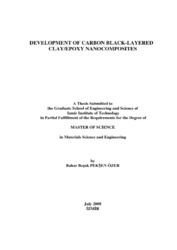Please use this identifier to cite or link to this item:
https://hdl.handle.net/11147/3924Full metadata record
| DC Field | Value | Language |
|---|---|---|
| dc.contributor.advisor | Tanoğlu, Metin | - |
| dc.contributor.author | Pekşen Özer, Bahar Başak | - |
| dc.date.accessioned | 2014-07-22T13:52:42Z | - |
| dc.date.available | 2014-07-22T13:52:42Z | - |
| dc.date.issued | 2008 | - |
| dc.identifier.uri | http://hdl.handle.net/11147/3924 | - |
| dc.description | Thesis (Master)--Izmir Institute of Technology, Materials Science and Engineering, Izmir, 2008 | en_US |
| dc.description | Includes bibliographical references (leaves: 56-60) | en_US |
| dc.description | Text in English; Abstract: Turkish and English | en_US |
| dc.description | viii, 60 leaves | en_US |
| dc.description.abstract | In this study, a novel epoxy nanocomposite with electrical conductivity and having improved mechanical and thermal properties was synthesized. Carbon black/ epoxy composites and carbon black-layered clay/epoxy nanocomposites were prepared by mixing via 3-roll mill. The first type of the composite was produced to determine the percolation threshold concentration (Vc). The second type with constant carbon black concentration, slightly over Vc, was synthesized to investigate the influence of clay content on the thermal, mechanical, electrical and structural properties of nanocomposites. Carbon black used in the study was extra conductive filler with 30 nm spherical particles. Layered clay was Na+ Montmorillonite treated with ditallow dimethlyamine to assure better intercalation within the epoxy resin. Vc value was determined to be 0.2 vol% and 0.25 vol% carbon black was added together with varying clay contents to the epoxy system to produce nanocomposites. Only the nanocomposites with 0.5 vol. % clay loading showed electrical conductivity. However, the composites with higher clay loadings showed insulating behaviour due to hindrance of carbon black network by clay layers. According to the XRD results, nanocomposites exhibited some extent of exfoliation. It was found that tensile modulus values of the epoxy increased;however flexural modulus values remained constant, with increasing clay content.Elastic modulus of neat epoxy (3.7 GPa) was increased about 28 % with 0.5 vol% clay addition. Thermomechanical analysis results revealed that the storage modulus, glass transition temperature and initial degradation temperature of epoxy was slightly enhanced due to clay loading. | en_US |
| dc.language.iso | en | en_US |
| dc.publisher | Izmir Institute of Technology | en_US |
| dc.rights | info:eu-repo/semantics/openAccess | en_US |
| dc.subject.lcc | TA418.9.N35 P37 2008 | en |
| dc.subject.lcsh | Nanostructured materials | en |
| dc.subject.lcsh | Composite materials | en |
| dc.subject.lcsh | Carbon composites | en |
| dc.title | Development of Carbon Black-Layered Clay/Epoxy Nanocomposites | en_US |
| dc.type | Master Thesis | en_US |
| dc.institutionauthor | Pekşen Özer, Bahar Başak | - |
| dc.department | Thesis (Master)--İzmir Institute of Technology, Materials Science and Engineering | en_US |
| dc.relation.publicationcategory | Tez | en_US |
| dc.identifier.wosquality | N/A | - |
| dc.identifier.scopusquality | N/A | - |
| item.openairecristype | http://purl.org/coar/resource_type/c_18cf | - |
| item.languageiso639-1 | en | - |
| item.openairetype | Master Thesis | - |
| item.grantfulltext | open | - |
| item.fulltext | With Fulltext | - |
| item.cerifentitytype | Publications | - |
| Appears in Collections: | Master Degree / Yüksek Lisans Tezleri | |
Files in This Item:
| File | Description | Size | Format | |
|---|---|---|---|---|
| T000680.pdf | MasterThesis | 7.31 MB | Adobe PDF |  View/Open |
CORE Recommender
Page view(s)
310
checked on Mar 31, 2025
Download(s)
118
checked on Mar 31, 2025
Google ScholarTM
Check
Items in GCRIS Repository are protected by copyright, with all rights reserved, unless otherwise indicated.